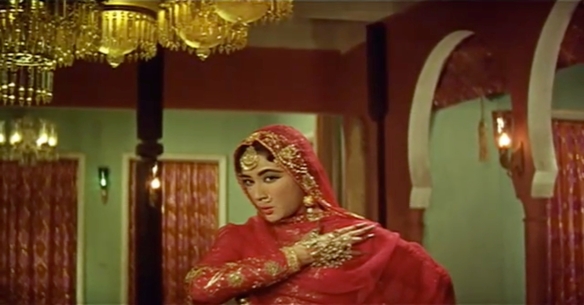Today, we continue our series on the eternally beautiful Pakeezah (1972) by providing the lyrics and English translation to inhii.n logo.n ne, a classic gem that has defined the genre of Bollywood mujras since its release.
Tuned by Ghulam Mohammed and penned by Majrooh Sultanpuri, this song was perhaps the most widely appreciated number (it reached #2 on the 1972 Binaca Geet Mala list!) from a soundtrack full of memorable compositions like chalte chalte and mausam hai aashiqaanaa. Although its light, Yaman-based melody evokes a playful sprit, the underlying tragedy expressed in the lyrics of this song is unexpectedly ironic. In spite of the pain she suffers from being stigmatized as a tavaaif, Meena Kumari is forced to render this mujraa with verve and a smile for her patrons at the brothel. While addressing her beloved saiyaa.n, she laments how the men around her have stolen her innocence and modesty, which is symbolically represented by the loss of her DupaTTaa. To persuade her lover, she implores him to ask three characters in the song to confirm that her virtue was soiled against her will: the cloth merchant, the cloth dyer, and the constable. Representing different facets of society, these characters serve as witnesses to her loss of innocence and sometimes take part in the process (e.g. when the constable snatches her scarf away at the market.) To add to the irony, the red color of the lost scarf and Meena Kumari’s on-screen outfit are reminiscent of the colors adorning a South Asian bride on her wedding day. Yet, the audience is acutely aware that a courtesan in such a position will provoke condemnation and disgust for attempting to engage in the conventional structures of love and marriage established by the society around her.
In addition to carrying a powerful message about social stigma in Indian society, these lyrics are memorable for their apabhransa (corrupt, non-grammatical) use of Urdu-Hindi. Reminiscent of the Awadhi dialect, a number of modifications to modern standard Hindi have been used here for poetic effect:
le liinaa = le liyaa (have taken)
bajajvaa = bajaj (cloth merchant)
hamrii = hamaarii (my, our)
sipaiyaa = sipaahii (constable)
bajariyaa = bazaar (market)
These substitutions really stick in the listener’s mind and give the lyrics of inhii.n logo.n ne a unique linguistic flavor that stands out from other compositions from the same period. Non-standard dialects such as Braj find prominence in classical Hindustani bandishes, but the lyricists for Bollywood cinema of the Golden Age tended to rely on standard Urdu-Hindi for most of their work.
Songs like inhii.n logo.n ne have historically cast a sympathetic light on the tragic lives led by courtesans of yesteryear, and it is a well-known fact that fans have been fascinated with this genre of music and movies since the earliest days of the Hindi film industry. To conclude, I’ll leave you with a thought-provoking question: given the conservative social climate of 1960s and 1970s India, why did courtesan-based films (e.g. Pakeezah, Mughal-e-Azam, Amar Prem) resonate intimately with Indian audiences? Although deep-seated stigmas surround tavaaifs and their profession, what is the driving force behind India’s obsession with the story of a courtesan with a heart of gold? Let us know your thoughts in the comments!
-Mr. 55
P.S. Check out a rare black and white version of this song filmed on a younger Meena Kumari in 1956 (16 years before the film’s eventual release)!

Meena Kumari’s playful spirit in ‘inhii.n logo.n ne‘ belies the tragic reality of her profession as a courtesan in Pakeezah (1972).
Inhi Logon Ne: Lyrics and Translation
inhii.n logo.n ne, inhii.n logo.n ne
These people, these people
inhii.n logo.n ne le liina DupaTTaa meraa
These people have taken away my scarf of modesty.
hamrii na maano, saiyaa.n, bajajvaa se puuchho
If you don’t accept my word, oh beloved, ask the cloth merchant
jis ne asharfii gaj diinaa DupaTTaa meraa
who sold me a yard of its fabric for a gold coin.
hamrii na maano, saiyaa.n, ra.ng rajvaa se puuchho
If you don’t accept my word, oh beloved, ask the cloth dyer
jis ne gulaabii ra.ng diinaa DupaTTaa meraa
who gave my scarf its pink color.
hamrii na maano, saiyaa.n, sipaiyaa se puuchho
If you don’t accept my word, oh beloved, ask the constable
jis ne bajariyaa me.n chhiinaa DupaTTaa meraa
who stripped away my scarf at the market.
inhii.n logo.n ne le liinaa DupaTTaa meraa
These people have taken away my scarf of modesty.
Glossary
le lenaa: to take away; DupaTTaa: a long scarf covering a woman’s chest, a traditional symbol of modesty and honor for Indian women; hamrii (baat): my word; maannaa: to accept, believe; bajajvaa: cloth merchant; asharfii: a gold coin issued by Muslim dynasties; gaj: a unit of measurement equivalent to a yard; saiyaa.n: beloved; rang rajvaa: cloth dyer; gulaabii: pink; sipaiyaa: constable; bajariyaa: market; chiinnaa: to strip away.


